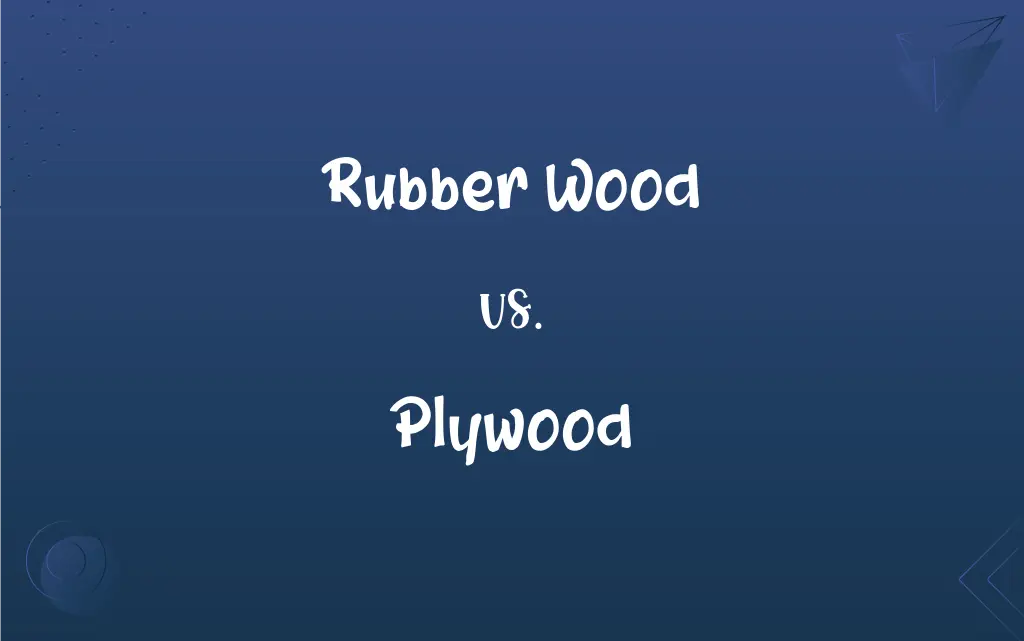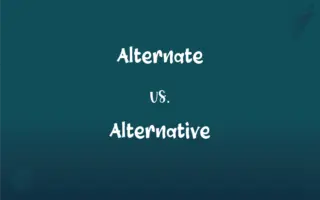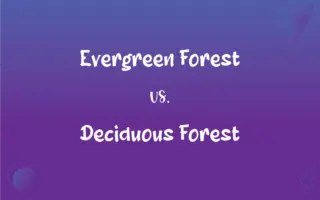Rubber Wood vs. Plywood: What's the Difference?
Edited by Aimie Carlson || By Harlon Moss || Updated on October 13, 2023
Rubberwood is an eco-friendly hardwood from rubber trees, while plywood is an engineered wood sheet made by gluing together thin veneer layers.

Key Differences
Rubberwood and plywood, distinctly different materials, cater to various needs in the woodworking and construction sectors. Rubberwood, hailing from the rubber tree, is recognized for its durable and eco-friendly attributes, while plywood, engineered from various wood veneers, offers strength and resistance to warping.
Regarding sustainability, rubberwood often stands out as it is sourced from used rubber trees that no longer produce latex. Plywood’s sustainability can be variant, depending on the source of the wood veneers and the manufacturing processes involved, which may or may not prioritize eco-friendly practices.
In terms of aesthetic and applications, rubberwood, being a solid wood, showcases a natural grain that can be highlighted through finishing, while plywood may not always display a natural wood aesthetic and is often utilized where the strength is prioritized over appearance.
The strength of rubberwood may be debated among woodworkers, but generally, it is considered sufficiently durable for furniture-making. Plywood is celebrated for its overall strength due to its cross-layered veneer construction, which resists breaking and warping effectively.
Cost-effectiveness between rubberwood and plywood varies based on factors like quality, grade, and application. Rubberwood is often prized for being a cost-effective hardwood, while plywood can range widely in price based on the types of wood used in its veneers and its overall quality.
ADVERTISEMENT
Comparison Chart
Material Origin
Solid wood from rubber trees
Engineered from several layers of wood veneers
Sustainability
Generally sustainable and eco-friendly
Varies, depending on wood source and production
Aesthetic & Grain
Displays a natural wood grain
May not display natural wood aesthetics
Strength
Durable, but can be softer than some hardwoods
Strong due to cross-layered construction
Cost
Often a cost-effective hardwood
Can range widely based on quality and wood type
ADVERTISEMENT
Rubber Wood and Plywood Definitions
Rubber Wood
Prone to mold and mildew if not properly treated.
Ensure rubberwood is adequately sealed to prevent fungal growth.
Plywood
Available in various grades and thicknesses.
Choose the appropriate plywood grade for specific project needs.
Rubber Wood
A hardwood obtained from rubber trees.
Rubberwood is often used in furniture manufacturing.
Plywood
Noted for its strength and stability.
Plywood remains stable under changes in temperature and humidity.
Rubber Wood
Sourced after trees cease latex production.
Rubberwood utilizes trees that are no longer viable for latex harvesting.
Plywood
Characterized by its cross-grained layer structure.
Plywood resists warping due to its layered construction.
Rubber Wood
Known for its eco-friendly attributes.
The use of rubberwood supports sustainable furniture production.
Plywood
Can be made from various types of wood.
Birch plywood is popular for its smooth, clean surface.
Rubber Wood
Typically light in color with a medium texture.
Rubberwood pieces are often stained to mimic more expensive woods.
Plywood
An engineered wood product made from wood veneers.
Plywood is commonly found in various construction applications.
Plywood
A structural material made of layers of wood glued together, usually with the grains of adjoining layers at right angles to each other.
Plywood
(uncountable) Construction material supplied in sheets, and made of three or more layers of wood veneer glued together, laid up with alternating layers having their grain perpendicular to each other.
After the hurricane there was a severe regional shortage of plywood, especially exterior plywood.
Plywood
(countable) A specific grade or type of this construction material.
We stock exterior plywoods, interior plywoods, and furniture plywoods.
Plywood
(transitive) To fit or block up with plywood.
Plywood
A laminate made of thin layers of wood
FAQs
What is rubberwood?
Rubberwood is a hardwood derived from rubber trees, often used in furniture making due to its durability and eco-friendliness.
Is rubberwood suitable for outdoor use?
Rubberwood is not ideal for outdoor use unless treated with a protective finish due to its susceptibility to fungus and insects.
Are there different types of plywood available?
Yes, plywood comes in various types and grades, such as softwood, hardwood, and marine plywood, each suitable for different applications.
What are the environmental impacts of using rubberwood?
Rubberwood is considered environmentally friendly as it makes use of trees that have ended their latex-producing cycle, turning potential waste into a resource.
How is plywood made?
Plywood is made by gluing together multiple thin layers of wood veneer, with each layer’s grain perpendicular to the adjacent layers, enhancing strength and stability.
What is a common application of plywood in construction?
Plywood is often used as a subflooring material in construction because of its strength and stability.
Is plywood environmentally friendly?
The environmental friendliness of plywood can depend on factors like the source of the wood veneers and the adhesive used in the manufacturing process.
Why is plywood often used in cabinetry?
Plywood is favored in cabinetry due to its strength, stability, and the smooth, appealing surface provided by higher-grade outer veneers.
Is rubberwood hypoallergenic due to its origin from rubber trees?
No, rubberwood is not necessarily hypoallergenic, and individuals with latex allergies should exercise caution.
Does plywood resist water?
Standard plywood is not water-resistant but can be treated or coated for water resistance, and there is also marine-grade plywood specifically designed for moist environments.
Can rubberwood be stained or painted?
Yes, rubberwood can be stained or painted, although its natural tones and grains are often considered aesthetically pleasing as-is.
Can plywood be used for making furniture?
Absolutely, plywood is a popular choice for furniture making due to its strength, stability, and potentially attractive veneer surface layers.
How does rubberwood resist warping and shrinkage?
Rubberwood has a natural resistance to warping and shrinkage, although it's not entirely immune to these issues, particularly in fluctuating environmental conditions.
What is veneer core plywood?
Veneer core plywood refers to a form of plywood where the central layer(s) are made from high-quality wood veneers, providing a balance between stability and aesthetic appeal.
Can plywood be recycled?
Plywood can be recycled or repurposed, but its recyclability can be limited due to the adhesives used in its manufacturing process.
Is rubberwood commonly used in the furniture industry?
Yes, rubberwood is widely used in the furniture industry due to its affordability and durability.
Are rubberwood products expensive?
Rubberwood is often considered a cost-effective hardwood alternative, though pricing can depend on various factors, such as design, brand, and craftsmanship.
How does rubberwood compare to other hardwoods in terms of durability?
Rubberwood is relatively durable compared to some hardwoods but is considered to be on the softer side among them, providing sufficient durability for many applications but not all.
Can rubberwood be used for flooring?
Rubberwood can be used for flooring, but it's not as common due to its softness compared to other hardwoods traditionally used for this purpose.
What affects the cost of plywood?
The cost of plywood is influenced by factors like the type of wood used for the veneers, the grade of plywood, the thickness, and overall quality.
About Author
Written by
Harlon MossHarlon is a seasoned quality moderator and accomplished content writer for Difference Wiki. An alumnus of the prestigious University of California, he earned his degree in Computer Science. Leveraging his academic background, Harlon brings a meticulous and informed perspective to his work, ensuring content accuracy and excellence.
Edited by
Aimie CarlsonAimie Carlson, holding a master's degree in English literature, is a fervent English language enthusiast. She lends her writing talents to Difference Wiki, a prominent website that specializes in comparisons, offering readers insightful analyses that both captivate and inform.































































